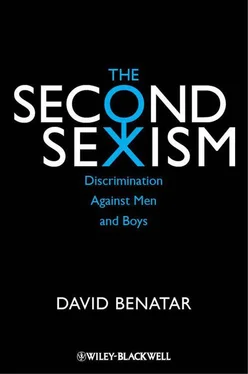Although this is my preferred account of what makes discrimination wrong, it is not necessary to accept this particular account in order to reach the conclusions for which I shall argue later in this book. It is possible for people with different accounts of what makes discrimination wrong to agree that specific instances of discrimination are wrongful. Thus my arguments in subsequent chapters will not presuppose a specific account of when discrimination is wrongful. In this way I hope to bypass at least some disagreement about what makes some discrimination wrong.
To give a specific example, we do not need to have an account of what makes discrimination wrong in order to know that excluding women from university (because they are women) amounts to wrongful discrimination. Similarly, we do not need to have such an account in order to know that laws permitting the corporal punishment of boys but not of girls amounts to wrongful discrimination. This is not to say that each of these discriminatory practices has not had its defenders. Instead it is to say that the best way to determine whether a given form of discrimination is wrong is to examine that specific treatment and all the considerations relevant to it. That is what I shall do in Chapter 4.
For this same reason it is not necessary, for those who do accept my preferred account, to give a more detailed account of when precisely a person’s sex is irrelevant. This question too can be bypassed. Moreover, it is not clear, in any event, that any more precise account could be given. There are so many different ways of treating people and so many different conditions under which they may be treated. To expect that a precise account can be given to cover all these cases is to expect more than can be provided. 8 8 I am not the only one to think this. For example, Sophia Moreau (“What is discrimination?” Philosophy and Public Affairs , 38(2), 2010) says that her view of discrimination “does not offer a single reductive explanation of the wrong of discrimination — that is, an explanation that traces the wrong of discrimination to some further single kind of normative fact that is operative in all cases” (p. 157). That it cannot be so reduced, she says, “reflects the complex nature of the type of injustice that we are trying to explain” (p. 157). She says that we can only address such questions “on a case-by-case basis” (p. 159). And she says that this is no more problematic for her “account than for any other account of discrimination” (p. 160). Iris Marion Young makes a similar claim about oppression. She says that “it is not possible to give one essential definition of oppression” (Iris Marion Young, Justice and the Politics of Difference , Princeton: Princeton University Press, 1990, p. 42).
Consider, for example, the breast cancer screening example above. Determining whether that is a case of justifiable discrimination depends on the relative risks of breast cancer faced by men and women, on the costs of competing screening policies and on the rationing principles one uses to distribute scarce resources. This is just one of very many contexts in which we need to determine whether discrimination is fair.
I shall refer to wrongful discrimination on the basis of sex as “sex discrimination,” “sexist discrimination” or “sexism.” 9 9 Some people use the term “sexual discrimination” but I prefer to avoid it as it is ambiguous between discrimination on the grounds of sexual orientation or activity and discrimination on the grounds of a person’s sex.
This seems like an entirely reasonable understanding of what sexism is. However, it is not uncontroversial and thus more needs to be said about this definition, its competitors and what is at stake between them.
The first thing to note is that there is no single, standard usage of the term “sexism.” It is used in many different ways, even by those who are united in opposing it. For example, Janet Radcliffe Richards defines it, albeit in passing, as counting “sex as relevant in contexts in which it is not.” 10 10 Janet Radcliffe Richards, The Sceptical Feminist , London: Penguin Books, 1994, p. 37. Martha Nussbaum shares this view. Although she does not explicitly define sexism, she says that liberal feminism (which obviously stands in opposition to sexism) takes sex to be a morally irrelevant characteristic in determining how people should be treated. ( Sex and Social Justice , New York: Oxford University Press, 1999, p. 10.)
Mary Anne Warren says that sexism “is usually defined as wrongful discrimination on the basis of sex” 11 11 Mary Anne Warren, Gendercide , Totowa, NJ: Rowman & Allanheld, 1985, p. 83.
and that discrimination “based on sex may be wrong either because it is based on false and invidious beliefs about persons of one sex or the other, or because it unjustly harms those discriminated against.” 12 12 Ibid., pp. 83–84.
Others think that a definition of this kind is inadequate and that sexism involves at least one further element, which is variably described as the subordination of one sex to the other, the domination of one sex by another or the oppression of one sex. 13 13 See, for example, Marilyn Frye, The Politics of Reality: Essays in Feminist Theory , Freedom, CA: The Crossing Press, 1983, p. 38; Iris Marion Young, Justice and the Politics of Difference , especially pp. 39–65.
Those who think that some such additional element is required for sexism to exist typically think that sexism must be a systemic phenomenon, because subordination, domination or oppression could not exist without systemic discrimination. They also think that such additional conditions for sexism preclude the possibility that males could be the victims of sexism. This is because they deny that males suffer from subordination or being dominated or oppressed. In addition they might deny that discrimination against males, even if it exists, is systemic in some other way.
There are innumerable versions and combinations of these views and I obviously cannot consider them all. However, I shall consider a few examples.
Richard Wasserstrom says that “racism and sexism should not be thought of as phenomena that consist simply in taking a person’s race into account… in an arbitrary way.” 14 14 Richard Wasserstrom, “On racism and sexism,” in Carol Gould (ed.), Gender , Atlantic Highlands, NJ: Humanities Press, 1997, pp. 337–358, at p. 347.
It must also be the case that this occur
in the context of a specific set of institutional arrangements and a specific ideology which together create and maintain a specific system of institutions, role assignments, beliefs and attitudes. That system is one, and has been one, in which political, economic, and social power and advantage is concentrated in the hands of those who are white and male. 15 15 Ibid.
According to this understanding of sexism, it must be systemic and the system must favor those who enjoy overall power. 16 16 The “systemic” requirement is not sufficient. Discrimination against males may well be systemic. Those who deny the existence of a second sexism thus also require the condition that the system favors those who hold overall power. (This assumes that males hold overall power. I shall return to this assumption later.)
Marilyn Frye is another who thinks that sexism must be systemic and to the overall advantage of some. She says that “the locus of sexism is primarily in the system or framework, not in the particular act” 17 17 Marilyn Frye, The Politics of Reality , p. 19.
and that the “term ‘sexist’ characterizes cultural and economic structures which create and enforce the elaborate and rigid patterns of sex-marking and sex-announcing which divide the species, along lines of sex, into dominators and subordinates.” 18 18 Ibid., p. 38. The precise wording of Professors Frye’s and Wasserstrom’s definition allows the possibility that males could be victims of sexism if discrimination against them were part of a system that concentrates power and advantage in the hands of (other?) males. However, it does not seem that either of them intended this loophole in their definitions.
Читать дальше
Конец ознакомительного отрывка
Купить книгу












